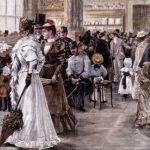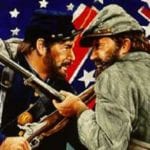 Technology
Technology  Technology
Technology  Humans
Humans 10 Everyday Human Behaviors That Are Actually Survival Instincts
 Animals
Animals 10 Animals That Humiliated and Harmed Historical Leaders
 History
History 10 Most Influential Protests in Modern History
 Creepy
Creepy 10 More Representations of Death from Myth, Legend, and Folktale
 Technology
Technology 10 Scientific Breakthroughs of 2025 That’ll Change Everything
 Our World
Our World 10 Ways Icelandic Culture Makes Other Countries Look Boring
 Misconceptions
Misconceptions 10 Common Misconceptions About the Victorian Era
 Mysteries
Mysteries 10 Strange Unexplained Mysteries of 2025
 Miscellaneous
Miscellaneous 10 of History’s Most Bell-Ringing Finishing Moves
 Technology
Technology Top 10 Everyday Tech Buzzwords That Hide a Darker Past
 Humans
Humans 10 Everyday Human Behaviors That Are Actually Survival Instincts
 Animals
Animals 10 Animals That Humiliated and Harmed Historical Leaders
Who's Behind Listverse?

Jamie Frater
Head Editor
Jamie founded Listverse due to an insatiable desire to share fascinating, obscure, and bizarre facts. He has been a guest speaker on numerous national radio and television stations and is a five time published author.
More About Us History
History 10 Most Influential Protests in Modern History
 Creepy
Creepy 10 More Representations of Death from Myth, Legend, and Folktale
 Technology
Technology 10 Scientific Breakthroughs of 2025 That’ll Change Everything
 Our World
Our World 10 Ways Icelandic Culture Makes Other Countries Look Boring
 Misconceptions
Misconceptions 10 Common Misconceptions About the Victorian Era
 Mysteries
Mysteries 10 Strange Unexplained Mysteries of 2025
 Miscellaneous
Miscellaneous 10 of History’s Most Bell-Ringing Finishing Moves
10 Ungilded Realities of Life in the Gilded Age
“Give me your tired, your poor,
Your huddled masses yearning to breathe free,
The wretched refuse of your teeming shore.
Send these, the homeless, tempest-tost to me,
I lift my lamp beside the golden door!”
–Emma Lazarus, “The New Colossus” (1883)
And come they did in their millions from across the ocean, seeking to enter the golden door Lady Liberty presides over to the American Dream beyond. America was still a land of opportunity in the closing decades of the 19th century, where anyone with perseverance could realize their wildest ambitions.
It seemed rich, powerful, and opulent, but beneath appearances was hidden the ugly underbelly of a society struggling to cope with the pressures of the Industrial Age. Mark Twain called the period roughly between 1870 and 1900 the “Gilded Age” for the glittering veneer covering up the less appealing reality.
Related: 10 Bleak Facts about Victorian Workhouses
10 Economic Inequality
One day in 1890, a man in New York slashed the horses of a carriage carrying two fashionable ladies out on a shopping spree. In lock-up, he moaned, “They don’t have to think of tomorrow. They spend in an hour what would keep me and my little ones for a year.” This incident encapsulates the yawning chasm between the rich and the poor in the Gilded Age.
In 1890, 11 million of the 12 million American families earned less than $1,200 a year; the average annual income was $380—below the poverty level. Meanwhile, “captains of industry” like John D. Rockefeller, Cornelius Vanderbilt, Andrew Carnegie, and Henry Ford amassed wealth, which, adjusted for inflation, would put them ahead of today’s tech and business giants. Rockefeller’s $400 billion (in today’s values) is double Jeff Bezos’s 2023 net worth.
The lavish spending habits of the rich, at a time when the average worker had barely enough to feed his family, fueled the bitterness among the poor felt by the aforementioned horse-slasher. Socialite Mamie Fish once hosted a birthday party for her dog, who showed up wearing a $15,000 diamond collar. Alva Vanderbilt bedecked her new $3 million ($90M today) Petit Chateau with $11,000 worth ($300,000 today) of flowers for an elaborate costume ball. Railway industrialist T. Harrison Garrett had a toilet of solid gold.
“Long ago, it was said that ‘one half of the world does not know how the other half lives’… It did not know because it did not care. The half that was on top cared little for the struggles, and less for the fate of those who were underneath…” wrote Jacob Riis in his book How the Other Half Lives. Not all the rich, of course. To their eternal credit, there were men like Andrew Carnegie who, following his own advice in his book The Gospel of Wealth, bequeathed his millions to charity.[1]
9 How Did the Other Half Live?
While the mansions of the rich were going up along New York’s Fifth Avenue, sprawling tenements housed the poor on the Lower East Side of the city. Hurriedly and shabbily constructed to accommodate—cram, to be exact—the wave of arriving immigrants into cheap quarters, tenements were firetraps and breeding grounds of diseases like cholera, typhus, and tuberculosis.
Ten to twenty people shared a 300-400 square-foot (28-37 square meter) space consisting of one bedroom, a kitchen, and a front room. Air shafts provided the only ventilation into the mostly dark, one-window apartments. There was no plumbing or running water, only a communal spigot in the hall. The communal toilet was also in the hall… or in an outhouse between tenements.
There were no elevators to serve the four- or five-story buildings, only unlighted rickety stairs. In the summer months, the inhabitants would sleep out on the fire escapes to find respite from the heat. On the streets outside, garbage piled up, its stench combining with that of manure from transport horses.[2]
8 The Struggles of Labor
The new immigrants coming to America were mostly from Europe. They were tough and hardy people, and they needed to be, as the factories where many of the men sought employment typically worked them 12 hours a day, 6 days a week, for as little as 10 cents an hour. Lack of safety regulations resulted in workers losing fingers, limbs—and worse—their lives, in accidents.
In 1884 alone, an average of 675 laborers a week were killed on the job. Employers considered them “negligent,” reason enough not to give them compensation. The injured could easily be replaced by fresh batches of new immigrants. Vacations and sick leave were out of the question.
Tasks were repetitive and deadening, and the rush to meet daily quotas discouraged workers from social interaction with their fellows. They were only permitted toilet breaks at lunchtime. Since many couldn’t speak English and were unschooled, some bosses treated them with contempt. To supplement their families’ meager income, women and children joined the workforce, facing the same horrible and dangerous conditions as the men for less pay.
One of the worst tragedies in NYC history, the Triangle Shirtwaist Factory fire, killed 146 mostly teenage girls. Children as young as five worked 14-hour days, leaving them neither time nor energy for school. John Spargo describes the boys working in coal mines:[3]
“Crouched over the chutes, the boys sit hour after hour… From the cramped position they have to assume, most of them become more or less deformed and bent-backed like old men… The coal is hard, and accidents to the hands, such as cut, broken, or crushed fingers, are common among the boys. Sometimes, there is a worse accident: a terrified shriek is heard, and a boy is mangled and torn in the machinery or disappears in the chute to be picked out later, smothered and dead. Clouds of dust fill the breakers and are inhaled by the boys, laying the foundations for asthma and miners’ consumption.”
7 Boss Tweed of Tammany Hall
The sinister alliance between big business and government, as always, thrives on corruption. During the Gilded Age, politicians allowed themselves to be bought by corporate millionaires for lucrative favors. No one epitomized the politics of the age more than William Tweed, the “boss” of Tammany Hall—the executive committee of the Democratic Party in New York City. Major cities were then under the thumb of a political party and its machine headed by the “boss.”
NYC was Democratic turf, and Boss Tweed ensured it stayed that way. In 1870, he bribed officials to make the city autonomous, giving him sole control over political offices and appointments. He accepted bribes for contracts and patronage and himself paid off judges for favorable rulings. Tweed and the Tammany ring specialized in electoral manipulation: fraud, vote-buying, and intimidation played out like a game.
Projects like hospitals, museums, courthouses, and the Brooklyn Bridge had their costs padded. All told, Tweed and his cronies raked in between $50 million and $200 million ($2.4 billion today) in corrupt money. The Boss owned a mansion on Fifth Avenue and a Connecticut estate and sported a 10-carat diamond on his lapel.
On the plus side, Tweed helped the immigrants and the poor in return for their votes. To make them eligible, he turned the NY Supreme Court into a “naturalization mill,” once supposedly churning out 60,000 new Americans in 20 days. The poor were grateful to The Boss for providing them jobs and basic services like food, medical care, and coal for the winter. He donated millions to charity. Tweed actually made life better for his constituents, and they repaid the debt by always voting Democrat.
In 1874, Tweed was convicted of embezzlement and sent to Blackwell Island prison, which was, you guessed it, under Tammany’s control. Tweed’s sentence was reduced from 12 years to one, a year which he spent in a “cell” with a velvet sofa, a library, and a view of Manhattan.
The next time Tweed was jailed, he had a two-bedroom apartment and was permitted to go on walks and carriage rides in Central Park. He escaped, fled—or more accurately, took a vacation—to Spain, was extradited back to the U.S., and finally died in prison in 1878.[4]
6 The Robber Barons
Many of the insanely wealthy in the Gilded Age acquired their fortunes by engaging in unethical and monopolistic practices. They were dubbed the Robber Barons because they were like medieval noblemen who literally robbed and killed people for spoils. The tactics of the new rich were less violent, of course, and more refined, but robbery nonetheless. These include buying out competitors, price fixing, union busting, and using their wealth to influence political legislation and public policy in their favor.
Most prominent among the robber barons were railway magnate Cornelius Vanderbilt, banker J.P. Morgan, steel tycoon Andrew Carnegie, and John D. Rockefeller, whose Standard Oil established its monopoly following the infamous “Cleveland Massacre” of 1872. Cleveland’s oil industry of numerous independent refineries was first threatened by Rockefeller’s secret deal with the railways to grant him bulk rate discounts under the name South Improvement Company.
Shipping rates doubled for everyone except Standard Oil and two other refineries. Riots denouncing Standard Oil followed, and the company was put on a blacklist. Drillers caught selling to SO were attacked and beaten. Its shipments were sabotaged, and railroads destroyed. In the wake of death threats, Rockefeller hired bodyguards and slept with a loaded revolver.
Though the South Improvement Company’s charter was revoked by the Pennsylvania legislature, SO was left in an unassailable position. The independent oilmen sensed it was useless to compete. So when Rockefeller told them, “Take Standard Oil stock, and your family will never know want,” many capitulated. Virtually overnight, 22 of his 26 competitors were bought out. One of those who defied SO was Frank Tarbell, who had spent years building up his business. He continued his hopeless fight until he was forced to mortgage his home to pay off his debts. Tarbell’s partner committed suicide.
Tarbell’s daughter Ida witnessed all these and swore to expose Rockefeller and his deplorable tactics. Years later, her book The History of the Standard Oil Company, a product of dogged investigative work, was instrumental in breaking up the monolith under the hammer of the Sherman Antitrust Act.[5]
5 The Battle of Homestead
America’s rapid industrialization in the closing decades of the 19th century signaled the inevitable clash between capital and labor that would consume the Gilded Age. Workers protesting their dehumanizing job conditions, the soulless capitalism of employers, and the laissez-faire attitude of government resulted in 10,000 strikes and lockouts in the 1880s. Things were not much improved in the 1890s.
At the time, the Carnegie Steel Corporation was the world’s largest manufacturing firm, while its workers were represented by the Amalgamated Association of Iron and Steel Workers, one of the largest unions in the U.S. Homestead, Pennsylvania, a few miles from Pittsburgh, was the site of Carnegie’s largest mill and managed by anti-union Henry Clay Frick.
Carnegie instructed Frick to break the union while he vacationed in Scotland, and Frick opened hostilities by cutting the workers’ wages. Predictably, the union rejected the cut, and in late June 1892, Frick shut down the mill and locked the workers out. On July 2, he fired all 3,800 workers and hired 300 private guards from the Pinkerton agency to occupy the plant.
Before dawn on July 6, thousands of workers and their families headed off the Pinkertons by the banks of the Monongahela River before they reached the plant. For the next 12 hours, the workers, armed with clubs, guns, and even a cannon, battled the outnumbered Pinkertons. The agents finally surrendered and were marched off to jail, enduring the gauntlet of savage blows rained upon them along the way. At least three Pinkertons and seven workers were killed in the battle.
However, the workers’ victory was short-lived. On the 12th, 8,500 National Guardsmen retook the mill. Several union leaders were imprisoned, and the workers had to submit to the reduced wages on top of the 12-hour day. Trade unionism and collective bargaining suffered a massive blow, ensuring more years of industrial war and violence between capital and labor. Unions were finally recognized by the New Deal in the 1930s.[6]
4 Red Emma
“Whoever lays his hands on me to govern me is a usurper and a tyrant, and I declare him my enemy!”
These words by Frenchman Pierre-Joseph Proudhon became the rallying point for many workers in the fight against capital and its government ally. Anarchism was an ideology that envisioned a stateless society without government, laws, and private property. To the downtrodden, it was a description of heaven on earth.
Though having an affinity with communism, anarchism differed significantly in its total repudiation of any authority. Hence, there was no effective anarchist organization, and isolated individuals carried out the “propaganda of the deed”—terror attacks on authority figures to draw attention to the anarchist philosophy.
Though they might be lone wolves, anarchists were as feared then as jihadists are today. The fear appeared justified: It was allegedly an anarchist bomb that killed seven policemen in the Chicago Haymarket Square riot in 1886. Emma Goldman was a young Russian-Jewish immigrant who, like many, felt that the eight anarchists arrested—of which four were executed—were innocent.
Already disillusioned with America as a factory worker earning $2.50 for a ten-and-a-half hour day, Goldman became a convert to anarchism. She became the most passionate and eloquent spokesperson for the cause and was given the sobriquet “Red Emma.” The public feared Red Emma’s speeches could provoke more violence. The attempted assassination of Frick at Homestead by her boyfriend Alexander Berkman didn’t help her reputation.
Goldman was implicated in the 1901 killing of U.S. President William McKinley when the anarchist assassin proclaimed one of her lectures as his inspiration. Goldman defended herself, saying, “As an anarchist, I am opposed to violence. But if the people want to do away with assassins, they must do away with the conditions which produce murderers.”
Aside from anarchism, Goldman advocated free love, free universal education, birth control, and women’s rights, but not suffragism because, as she said, “If voting changed anything, they’d make it illegal.” In 1919, Goldman and Berkman were deported back to Russia, where, after two years of living under Soviet communism, they realized it was just another form of tyranny. Leaving Russia, they lived a life of self-exile, and Emma finally ended up in Toronto, where she died in 1940.[7]
3 Bloody Los Angeles
It was not only African Americans who endured discrimination in the Gilded Age. A backlash against unrestricted immigration was already beginning with the coming of new immigrants from Southern and Eastern Europe and Asia with values, cultures, languages and political backgrounds differing significantly from the old immigrants from Northern Europe.
Bearing the brunt of discrimination were the Catholic Irish and Italians. The Irish were looked down upon as troublesome drunkards, while Italians were despised for being poor, clannish, and illiterate and were perennially suspected of being criminals and anarchists. More than 20 Italians were lynched by mobs in the 1890s. In New Orleans in 1891, 11 Sicilians were executed by a mob of 10,000 in the wake of a policeman’s murder.
But one of the largest mass lynchings in U.S. history took place not in the Jim Crow South but in Los Angeles, a gateway city for Asian immigrants. Almost as soon as they first set foot in America, the Chinese were targeted for persecution by whites who felt their jobs were being threatened by cheap “coolie” labor. The Ku Klux Klan undertook a campaign of assault and arson throughout California. The editor of the Los Angeles News (who employed a Chinese cook) called the immigrants “an alien, inferior, and idolatrous race… hideous and repulsive.” The match was set to the tinder.
On October 24, 1871, 500 whites and Hispanics stormed L.A.’s Chinese district after a gunbattle between suspected Chinese gang members and police left a white saloonkeeper dead. The mob mutilated and killed every Chinese they met. The residents took shelter in an adobe building which the mob forcibly entered.
After two hours, 19 Chinese lay dead, including a respected doctor and an adolescent boy. The eight rioters convicted of manslaughter were released after a year on a technicality.[8]
2 “I Will Fight No More Forever”
The final downfall of Native American tribes was perhaps the most tragic legacy of the Gilded Age—a people who had the continent to themselves for thousands of years now reduced to penury in reservations and forced to assimilate into white culture. Wars, massacres, forced removal from their ancestral lands, and the destruction of their main source of food, the bison, all contributed to the near-genocide.
In the spring of 1877, the government asked the Nez Perce to vacate their lands in Wallowa Valley in Oregon despite promising that their home would be free from white settlement. Chief Joseph wanted no more violence and prepared his tribe to quietly leave the place where their ancestors lie buried—”that beautiful valley of winding waters” that he loved “more than all the rest of the world.”
But despite his efforts, fighting erupted, and the few hundred Nez Perce warriors scored a victory against General Nelson Miles at White Bird Canyon, Idaho. Fighting as they trekked the arduous 1700 miles to Canada, the tribe was able to evade the superior U.S. Army at every turn.
But by October, with winter approaching, their numbers were reduced from 750 men, women, and children to 400, and weakened by lack of food and exhaustion, they were finally overrun at Bear Paw Mountain, Montana. Chief Joseph and the decimated tribe surrendered to General Miles. “I am tired of fighting. The old men are all killed. The little children are freezing to death. From where the sun now stands, I will fight no more forever.”
Printed in Harper’s Weekly, the words burned into the public’s mind with their quiet dignity, banishing stereotypes of the Indian as a primitive savage. But Chief Joseph did continue to fight—through words—as he traveled to Washington to remind the authorities to honor their promise. All in vain. The Nez Perce were never restored to Wallowa Valley.[9]
1 The Cross of Gold
Rural America was far from idyllic for farmers in the Gilded Age. With rapid industrialization, more people were flocking into cities, but a majority still lived and worked on farms. Their lives were a constant struggle against drought and pests. Natural disasters aside, they also had to deal with man-made problems: discriminatory railroad rates, monopolistic prices on equipment and fertilizer, and predatory corporations that gobbled up vast tracts of arable land.
Farmers had more efficient tools for growing crops, and bumper harvests of corn, wheat, and cotton were common. But even as production rose, prices fell due to the inability of the money supply to keep up with the growing economy. A farmer who borrowed $1,000 in 1881 when corn sold for 63 cents a bushel needed 790 more bushels to repay it five years later, in addition to the 312 he needed to pay off the 10% interest. Thousands of farmers went into debt and lost their land.
The country was tied to the gold standard, so why not, many argued, monetize the abundant silver being hauled out of Western mines to shore up the money supply? When the gold reserves dipped below $100 million in 1893, there was a financial panic. The great Pullman strike and the march of Coxey’s army of the unemployed on Washington dramatized the hardships of ordinary people. The Silverites found their leader in Nebraska congressman William Jennings Bryan.
Bryan ran for Democratic nominee for president in 1896, and in the convention in Chicago, made an immortal speech for silver, ending with the words that put the audience in thrall and secured the nomination: “You shall not press down upon the brow of labor this crown of thorns. You shall not crucify mankind upon a cross of gold!” Bryan lost the election to McKinley, and the U.S. had to endure another Great Depression before abandoning the gold standard in 1933.
It is fitting that the Gilded Age ended in a panic that drove home the truth that “all that glitters is not gold.”[10]








